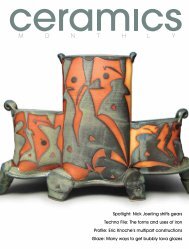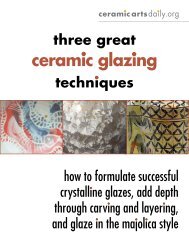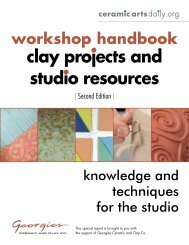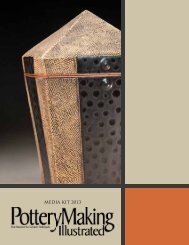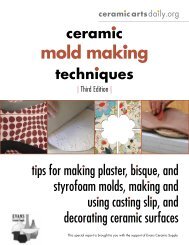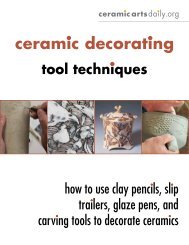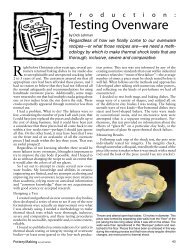Volume6. Issue1 - Ceramic Arts Daily
Volume6. Issue1 - Ceramic Arts Daily
Volume6. Issue1 - Ceramic Arts Daily
You also want an ePaper? Increase the reach of your titles
YUMPU automatically turns print PDFs into web optimized ePapers that Google loves.
2<br />
NEWSLETTER STAFF<br />
EDITOR<br />
Renée Fairchild<br />
rfairchild@ceramics.org<br />
MARKETING MANAGER, MEMBERSHIP<br />
Danielle McIntosh<br />
dmcintosh@ceramics.org<br />
PROOFREADER<br />
Jennifer Poellot<br />
jpoellot@ceramics.org<br />
ADVERTISE<br />
Reserve your space today and reach ceramics<br />
artists of all levels and interests.<br />
Contact Debbie Plummer<br />
dplummer@ceramics.org<br />
The official newsletter of The Potters Council of The American<br />
<strong>Ceramic</strong> Society<br />
© The American <strong>Ceramic</strong> Society<br />
The American <strong>Ceramic</strong> Society assumes no responsibility for<br />
the statements and opinions advanced by the contributions<br />
to its publications. Registered names and trademarks, etc., used<br />
in this publication, even without specific indication thereof,<br />
are not to be considered unprotected by law.<br />
L E T T E R F R O M T H E P R E S I D E N T<br />
POTTERY FOR PIXELS<br />
D AV I D H E N D L E Y, P O T T E R S C O U N C I L P R E S I D E N T<br />
With each passing year, it seems like I spend more and more time staring at a computer screen or<br />
otherwise fooling with some new technology or digital medium. I’m not complaining; both my<br />
personal life and my career as a potter are better as a result. The great thing about technology<br />
is that it “levels the playing field.” Here I am, out in rural east Texas, yet I can easily be in<br />
communication with people all over the world. I can take pictures of the pots from a firing of my<br />
kiln, format the pictures, put them on the World Wide Web, and offer them for sale all on the same<br />
day they are unloaded. I can design a new brochure, send the files to a printer in Cleveland and<br />
receive the finished product next week. It’s now possible to bypass the professionals whose expertise<br />
and equipment was needed to complete a project in the old predigital age.<br />
But (you knew there was a “but” coming, didn’t you), it seems like the more time I spend on these<br />
ancillary activities the less time I have to actually make pots. Interestingly and more importantly, it<br />
seems like spending a lot of time with a computer can actually change the way my mind works. I’ve<br />
found that it is difficult for me to get a good night’s sleep if I spend a lot of time with the computer<br />
in the evening. I keep seeing those little icons and wanting to click on them.<br />
In contrast, an evening working with clay usually portends a good restful night’s sleep. I think<br />
there are a couple of reasons. First, since there is actual physical work involved, even though it is<br />
not usually strenuous, it serves to make the body tired and ready for rest. Second, I think the brain<br />
is functioning in a different way when working directly with a material rather than with abstract<br />
representations of things.<br />
When I am in the throes of working on a series of pots and thinking about design and process,<br />
this mindset seems to carry over to other areas. I find myself thinking in three dimensions. It’s just<br />
a different way to perceive objects in the environment. I have always been interested in extruding<br />
as a means of forming clay. To broaden this idea even further, I have noticed several times when I<br />
have spent large amounts of time thinking about and designing extruder dies, that, again, my brain<br />
carries this way of looking at things over to other areas. I notice an object and immediately try to<br />
picture what a die to produce that shape would look like.<br />
I think this is why many people are drawn to clay as a hobby. With more and more jobs requiring<br />
abstract reasoning and manipulating pixels rather than concrete material, it’s a welcome change to<br />
grab some clay and shape it. But I’m worried that the younger generation is just not as interested in<br />
such things. They are so comfortable with technology, and it is so pervasive that it can seem like<br />
the only way to relate to the world and the only way to think. Statistically, we members of Potters<br />
Council are a pretty old group. The Board of Directors has been trying to come up with ideas for<br />
getting more young people involved with clay generally and the Potters Council specifically, so if<br />
you have any ideas, please share them with us.<br />
Spending time with clay can seem pretty old and unexciting compared to all the opportunities for<br />
trying the latest new thing. We need to bring back some balance. We all need to share our excitement<br />
about working with clay and do whatever we can to make sure more people, especially children, have<br />
opportunities to try their hands at crafts such as ceramics. I can tell you from experience that many<br />
kids know nothing about clay. But most, once they are shown a few things, like it, and in today’s<br />
world, any activity with kids that does not involve electronics is a good thing.<br />
Conversely, when talking with potters I’ve been surprised at how many Luddites there are out<br />
there who know nothing about all the modern resources that are available today. We may make<br />
things by hand, but learning how to use tools such as glaze calculation programs, the Internet, and<br />
digital cameras are well worth the effort. Maybe we need to institute a learning exchange program:<br />
pottery classes for computer lessons? Find a willing teenager and start a dialog!



